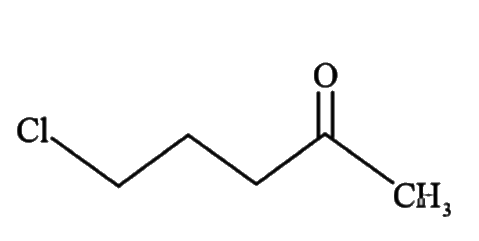The major product of the following reaction :
is :
.
The correct Answer is:A
To solve the problem, we need to analyze the reaction involving the compound (CH₃O)₂CO and the reagent C₂H₅MgBr under hydrolysis conditions. Let's break down the steps involved in determining the major product of this reaction.
1. Identify the Reactants:
The reactants are (CH₃O)₂CO (dimethyl carbonate) and C₂H₅MgBr (ethyl magnesium bromide), which is a Grignard reagent.
2. Understand the Reaction:
Grignard reagents react with carbonyl compounds (like ketones and aldehydes) to form alcohols. In this case, (CH₃O)₂CO has a carbonyl group (C=O) that can react with the Grignard reagent.
3. Nucleophilic Attack:
The ethyl group (C₂H₅) from the Grignard reagent acts as a nucleophile and attacks the carbonyl carbon of (CH₃O)₂CO. This leads to the formation of a tetrahedral intermediate.
4. Formation of the Intermediate:
The tetrahedral intermediate will have the structure:
(CH₃O)C(OH)(C₂H₅)(OCH₃)
Here, one of the methoxy groups (OCH₃) is still attached to the carbon.
5. Collapse of the Intermediate:
The tetrahedral intermediate will collapse, leading to the elimination of one of the methoxy groups. This gives us a ketone:
C₂H₅C(=O)(OCH₃)
6. Second Nucleophilic Attack:
The same Grignard reagent (C₂H₅MgBr) can attack the newly formed ketone. The ethyl group again attacks the carbonyl carbon, forming another tetrahedral intermediate.
7. Final Product Formation:
Upon hydrolysis (addition of water and acid), the final product will be:
C₂H₅C(OH)(C₂H₅)(O)
This can be simplified to:
C₂H₅C(OH)(C₂H₅)O
or written as:
C₂H₅C(OH)(C₂H₅)O
8. Conclusion:
The major product of the reaction is:
C₂H₅C(OH)(C₂H₅)O
This is a tertiary alcohol with two ethyl groups attached to the carbon bearing the hydroxyl group.
Final Answer:
The major product of the reaction is:
C₂H₅C(OH)(C₂H₅)O
---
The reactants are (CH₃O)₂CO (dimethyl carbonate) and C₂H₅MgBr (ethyl magnesium bromide), which is a Grignard reagent.
Grignard reagents react with carbonyl compounds (like ketones and aldehydes) to form alcohols. In this case, (CH₃O)₂CO has a carbonyl group (C=O) that can react with the Grignard reagent.
The ethyl group (C₂H₅) from the Grignard reagent acts as a nucleophile and attacks the carbonyl carbon of (CH₃O)₂CO. This leads to the formation of a tetrahedral intermediate.
The tetrahedral intermediate will have the structure:
(CH₃O)C(OH)(C₂H₅)(OCH₃)
Here, one of the methoxy groups (OCH₃) is still attached to the carbon.
The tetrahedral intermediate will collapse, leading to the elimination of one of the methoxy groups. This gives us a ketone:
C₂H₅C(=O)(OCH₃)
The same Grignard reagent (C₂H₅MgBr) can attack the newly formed ketone. The ethyl group again attacks the carbonyl carbon, forming another tetrahedral intermediate.
Upon hydrolysis (addition of water and acid), the final product will be:
C₂H₅C(OH)(C₂H₅)(O)
This can be simplified to:
C₂H₅C(OH)(C₂H₅)O
or written as:
C₂H₅C(OH)(C₂H₅)O
The major product of the reaction is:
C₂H₅C(OH)(C₂H₅)O
This is a tertiary alcohol with two ethyl groups attached to the carbon bearing the hydroxyl group.
The major product of the reaction is:
C₂H₅C(OH)(C₂H₅)O
Similar Questions
Knowledge Check
What is the major product of the following reaction ?
CH3−C≡NCH3MgI−−−−→Et2OH3O⊕−−−→ACH3−CH2−NH−CH3B CCH3−O∣∣C−CH3DCH3−CH2−O∣∣C−OH
CCH3−O∣∣C−CH3DCH3−CH2−O∣∣C−OH
Products of the following reaction,
CH3−C≡CCH2CH3(i)O3−−−−−−−−→(ii)Hydrolysis? are:
View SolutionWrite major product in the following reactions :
C6H5−CH=CH2+B2H6H2O2−−−→NaOH
View SolutionPredict the major product in the following reaction :
C6H5−CH2CO2CH3(i)CH3MgBr(Excess)−−−−−−−−−−−−−−→(ii)H⊕.
View SolutionThe major product of the following reaction is :
C6H5CH2−CH3∣C∣Br=CH2−CH3C2H5ONa−−−−−→C2H5OH
View SolutionThe major product of the following reaction is :
C6H5CH2−CH3∣C∣Br−CH2−CH3C2H5ONa−−−−−→C2H5OH
View SolutionIdentify and explain the formation of the products in the following reaction :
CH3 |CH3−C−CH2Br C2H5OH−−−−−−−→heat | CH3
View SolutionThe major product in the following reaction is

1.CH3MgBr,dry ether ,0∘−−−−−−−−−−−−−−−−→2. aqueous acid
View Solution
